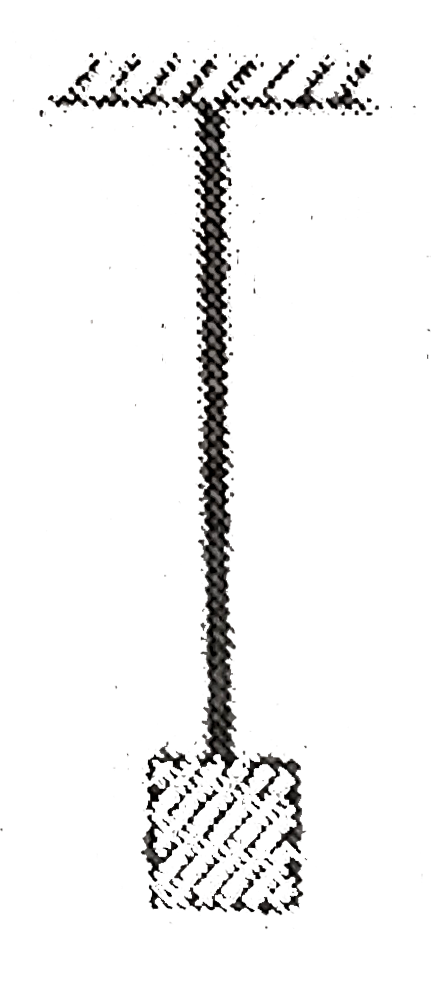The Young's modulus of a steel wire of length 6m and cross–sectional area 3mm2 , is 2×1011Nm2. the wire is suspended from its support on a given planet. A block of mass 4 kg is attached to the free end of the wire. The acceleration due to gravity on the planet is 14 of its value on the earth. The elongation of wire is (Take g on the earth = 10ms2) :
0.1cm
1mm
1cm
0.1mm
The correct Answer is:D
To solve the problem, we need to find the elongation of a steel wire when a block of mass is attached to it. We will use the formula for elongation based on Young's modulus.
Given Data:
- Length of the wire, L=6m
- Cross-sectional area, A=3mm2=3×10−6m2
- Young's modulus, Y=2×1011N/m2
- Mass of the block, m=4kg
- Acceleration due to gravity on the planet, g′=14g where g=10m/s2
Step 1: Calculate the effective acceleration due to gravity on the planet.
g′=14×10m/s2=2.5m/s2
Step 2: Calculate the force exerted by the block on the wire.
The force F due to the weight of the block is given by:
F=m⋅g′=4kg×2.5m/s2=10N
Step 3: Calculate the stress in the wire.
Stress σ is defined as force per unit area:
σ=FA=10N3×10−6m2=103×10−6=10×1063N/m2≈3.33×106N/m2
Step 4: Calculate the elongation of the wire using Young's modulus.
The formula for elongation ΔL is given by:
ΔL=σLY
Substituting the values we have:
ΔL=(3.33×106)×62×1011
ΔL=19.98×1062×1011=19.982×10−5=9.99×10−6m
ΔL≈1.0×10−5m=0.00001m=0.01cm
Final Answer:
The elongation of the wire is approximately 1.0×10−5m or 0.01cm.
---
- Length of the wire, L=6m
- Cross-sectional area, A=3mm2=3×10−6m2
- Young's modulus, Y=2×1011N/m2
- Mass of the block, m=4kg
- Acceleration due to gravity on the planet, g′=14g where g=10m/s2
g′=14×10m/s2=2.5m/s2
The force F due to the weight of the block is given by:
F=m⋅g′=4kg×2.5m/s2=10N
Stress σ is defined as force per unit area:
σ=FA=10N3×10−6m2=103×10−6=10×1063N/m2≈3.33×106N/m2
The formula for elongation ΔL is given by:
ΔL=σLY
Substituting the values we have:
ΔL=(3.33×106)×62×1011
ΔL=19.98×1062×1011=19.982×10−5=9.99×10−6m
ΔL≈1.0×10−5m=0.00001m=0.01cm
The elongation of the wire is approximately 1.0×10−5m or 0.01cm.
Topper's Solved these Questions
Similar Questions
A copper wire of negligible mass, 1m length and cross-sectional area 106m2 is kept on a smooth horizontal table with one end fixed. A ball of mass 1kg is attached to the other end. The wire and the ball are rotating with an angular velocity of 20rad/s. If the elongation in the wire is 10−3m.
a. Find the Young's modulus of the wire (in terms of ×1011N/m2).
b. If for the same wire as stated above, the angular velocity is increased to 100rad/s and the wire breaks down, find the breaking stress (in terms of ×1010N/m2).
View SolutionA steel wire of negligible mass length L0 and cross sectional area A0 is kept on a smooth horizontal table with one end fixed. A ball of mass M is attached to the other end. The wire and ball are rotating with angular velocity ω . If elongation in the wire is ΔL, then the value of Young's modulus of elasticity will be
View Solution
Knowledge Check
The Young's modulus of a wire of length 2m and area of cross section 1mm2 is 2×1011N/m2. The work done in increasing its length by 2mm is
A0.1 JB0.2 JC0.02 JD0.4 JA metal wire of length L is suspended vertically from a rigid support. When a bob of mass M is attached to the lower end of wire, the elongation of the wire is l:
AThe loss in gravitational potential energy of mass M is Mgl.BThe elastic potential energy stored in the wire is MglCThe elastic potential energy stored in the wire is 12MglDHeat produced is loss of mechanical energy of system is 12MglA wire of length l, area of cross-section A and Young,s modulus of elasticity Y is suspended form the roof of a building. A block of mass m is attached at lower end of the wire. If the block is displaced from its mean position and released then the block starts oscillating. Time period of these oscillations will be
 A2π√AlmYB2π√AYmlC2π√mlYAD2π√mYal
A2π√AlmYB2π√AYmlC2π√mlYAD2π√mYal
A metal wire of negligible mass, length 1 m and cross-sectional area 10−6m2 is kept on a smooth horizontal table with one end fixed on the table. A ball of mass 2kg is attached to the other end of the wire. When the wire and the ball are rotated with angular velocity of 20 rad/s, it is found that the wire is elongated by 10−3m. If the Young's modulus of the metal is n×1011N/m2, then the value of n is
View SolutionA uniform steel wire of length 3.14 m and diameter 2×10−3 m is fixed at its upper end. When a mass of 10 kg is attached to its lower end, the extension of the wire is 1×10−3 m. The Young's modulus of elasticity is,
View SolutionA brass wire of cross-sectional area 2mm2 is suspended from a rigid support and a body of volume 100cm2 is attached to its other end. If the decrases in the length of the wire is 0.11mm, when the body is completely immersed in water, find the natural length of the wire.
View SolutionA wire 2 m in length suspended vertically stretches by. 10 mm when mass of 10 kg is attached to the lower end. The elastic potential energy gain by the wire is (take g = 10m/s2)
View SolutionAn alumminium rod and steel wire of same length and cross-section are attached end to end. Then compound wire is hung fron a rigid support and load is suspended from the free end. Y for steel is (207) times of aluminium. The ratio of increase in length of steel wire to the aluminium wire is
View Solution
